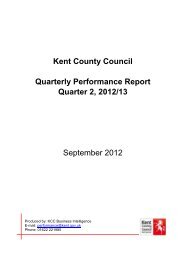Sexualisation of Young People Review
Sexualisation of Young People Review
Sexualisation of Young People Review
Create successful ePaper yourself
Turn your PDF publications into a flip-book with our unique Google optimized e-Paper software.
<strong>Sexualisation</strong> <strong>of</strong> <strong>Young</strong> <strong>People</strong> <strong>Review</strong><br />
is that the ‘sexualisation <strong>of</strong> culture’ 77 is a<br />
sign <strong>of</strong> cultural degradation. 78 To enter<br />
into this debate is beyond our remit;<br />
rather, our concern is to map out, through<br />
clear analysis <strong>of</strong> the empirical research<br />
literature, the possible links between the<br />
sexualisation <strong>of</strong> culture and gendered and<br />
sexualised violence.<br />
Broadly, those academics who accept<br />
the phenomenon <strong>of</strong> sexualisation<br />
approach it in two ways. On the one<br />
hand, so-called ‘mainstream sexualisation’<br />
describes the democratisation <strong>of</strong> sex<br />
and sexuality and the breaking down <strong>of</strong><br />
binary oppositions (for example, male/<br />
female or heterosexual/homosexual). On<br />
the other, there is the commercialisation<br />
<strong>of</strong> sexuality which may well involve the<br />
appropriation <strong>of</strong> feminist terminology<br />
such as ‘empowerment’, ‘equality’ and ‘girl<br />
power’. Arguably, this serves to reinforce<br />
the dominant male gaze, by ensuring that<br />
female sexual expression only gains validity<br />
under the surveillance <strong>of</strong> men; something<br />
that may be leading to increases in<br />
sexualised violence among young people. 79<br />
Understanding the current<br />
phenomenon <strong>of</strong> sexualisation<br />
The term ‘sexualisation’ is used to describe<br />
a number <strong>of</strong> trends in the production and<br />
consumption <strong>of</strong> contemporary culture; the<br />
common denominator is the use <strong>of</strong> sexual<br />
attributes as a measure <strong>of</strong> a person’s<br />
value and worth. Although sexualised<br />
images have featured in advertising and<br />
communications since mass media first<br />
emerged, the current phenomenon <strong>of</strong><br />
sexualisation differs from what has gone<br />
before in three important regards.<br />
First, the volume <strong>of</strong> sexualised images<br />
and the extent to which they impinge on<br />
everyday life are significantly greater than<br />
they were as recently as two decades ago.<br />
Public spaces are saturated with sexualised<br />
images and messages. 80 As a result, they<br />
are visible to everyone, including children<br />
and young people who may not have<br />
the maturity to rationalise and put what<br />
they are seeing into context. At the same<br />
time, these images and messages are also<br />
becoming more explicit. Increasingly, it<br />
seems, there is a blurring between the<br />
‘mainstream’ media, whether in the form<br />
<strong>of</strong> billboard posters, magazine covers,<br />
music videos, fashion shoots or film trailers,<br />
and the world <strong>of</strong> pornography.<br />
Second, because <strong>of</strong> the proliferation <strong>of</strong><br />
visual images, ‘social classifiers’ such as<br />
gender, class, race and age are being used<br />
to present exaggerated constructions <strong>of</strong><br />
femininity and masculinity. The resulting<br />
caricatures – the big-breasted blonde<br />
bimbo, the ‘dirty old man’ – are defined<br />
solely by their sexual attributes, attitudes<br />
or behaviours. 81 In the case <strong>of</strong> the blonde<br />
bimbo, too, there is a strong link between<br />
apparent sexually availability and validation;<br />
the ‘right’ physical attributes and the<br />
willingness to submit to male desires are a<br />
‘passport’ to acceptance, money and fame.<br />
Third, children are increasingly being<br />
portrayed in an ‘adultified’ way while,<br />
conversely, adult women are being<br />
infantilised. 82 This leads to a blurring <strong>of</strong><br />
the lines between sexual maturity and<br />
immaturity. This is having the effect <strong>of</strong><br />
sexualising girlhood and legitimising the<br />
notion that children can be related to as<br />
sexual objects.<br />
24<br />
77<br />
Gill (2009); Zurbriggen et al. (2007); McNair<br />
(2002); Paul (2005); Rush and La Nauze (2006)<br />
78<br />
Hitchens (2002); Paul (2005)<br />
79<br />
Barter, McCarry, Berridge and Evans (2009)<br />
80<br />
McNair (2002)<br />
81<br />
Paasonen (2007)<br />
82<br />
Evidence provided to the review by<br />
Dr K. Sarikakis (2009)

















